
(Sequoia and Yosemite National Parks)
by Connie Barlow
May 2005
During my quests for California Torreya in Sequoia and Yosemite national parks (in May 2005), I found that T. californica is, as the literature states, locally abundant wherever it is found, and seems to be reproducing well in those spots, both from seeds and from stump sprouts of older rootstock. There was no easily observable evidence of disease. The only problem for this species is that it is not widespread: the localities where it is found are few, spotty, and very limited in size. Note: Companion scout for Sequoia National Park was HAROLD WOOD (of Visalia); for Yosemite National Park was my husband, MICHAEL DOWD.
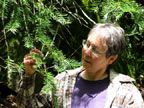
VEGETATION Associations for Torreya in the Sierras
Although the literature shows a wide range of plant associations, I observe that California Torreya in the SIERRAS seems to associate well with a rather low overstory of California Live Oak (evergreen) and California Bay Laurel (also evergreen). Torreya occasionally joins those two dominant overstory trees, even breaking through and topping out (though not spreading out) above them.
 1
1  2
2
1: Two brilliant green and bushy canopy-level torreyas (in lower left corner).
2: Understory torreya (left) on a shady slope in which Bay Laurel and Live Oak
form the primary canopy, along with some White Oak and Bigleaf Maple.
[Left is Yosemite; right is Sequoia National Park]
I found California Torreya in 3 locations: 1 in Sequoia National Park (4100 feet elevation) and 2 in Yosemite (elevations approximately 5000 and 3500 feet). California Torreya seems to occur at an altitude or slope aspect above California Buckeye and below the Ponderosa Pine level. Ponderosa Pines are rather rare (if present at all) in Torreya habitat, and Douglas Fir practically nonexistent. In higher or moister/cooler habitats nearby I found a lot of sapling Douglas Fir and Incense Cedar that seemed to be filling the same niche of understory evergreen conifer. Overall, wherever I found a lot of understory or canopy-level Douglas Fir or Incense Cedar, I found no California Torreya.
 3
3  4
4
3: Torreya with California Bay Laurel, and 4: Poison Oak
Another interesting positive association was that in all 3 locales, Poison Oak was in close association with a good portion of the California torreya specimens, sometimes abundantly so. At higher altitudes or conditions (such as Yosemite Valley), where Poison Oak dropped out, so did Torreya. Again, this was a positive sample of only 3 sites, but it may prove to mean something helpful for considering assisted migration for the Florida species.
The slopes where I found California torreya were all very much or somewhat south-facing, although that may be an artifact of road construction preferences on south-facing slopes.
SPECULATION: My sense is that T. tax might do well in the southern Appalachians and Cumberland Plateau on steep mountain or ravine slopes that face southward, in opposition to Eastern Hemlock growing on the north-facing slopes or in ravine bottoms just above the riparian zone. It may also do well in the zones just upslope of thick rhododendron groves — that is, where the Rhododendron drop out completely and the forest floor opens up. (Torreya will never be found in the riparian zone itself, however.)
SPECULATION: Overall, I get the sense that T. californica does best where it is the only conifer attempting to fill the understory niche, and where the overstory trees have a habit of spreading widely and creating a lot of shade, such that the ground itself is rather bare of plants (though has a nice bed of decomposing leaves) for seed germination.
In Yosemite, the overstory trees were almost exclusively non-conifer evergreen (Live Oak and California Bay Laurel). In Sequoia National Park, the overstory included both of those evergreen species, though, because this site was mositer than the Yosemite sites, it supported taller specimens of each, sometimes with amazingly big trunk girths). The site in Sequoia National Park also supported a good number of tall deciduous White Oak and very impressively tall Bigleaf Maples, and just a few White Pines.
 5
5  6
6
5 and 6: Torreya seedlings amid decomposing broad leaves.
Observations and Speculations on the NONLIVING ENVIRONMENT
I get the sense that California torreya prefers SUNNY conditions, but rarely can it find a spot in which it can have a lot of sun without feeling the pinch of either unwelcome understory competition or outright drought. So it simply grows within the shade of the overstory. Perhaps its upper altitudinal range is limited not so much by cold, snowpack, or reduced growing season, but simply by the moister conditions that allow Douglas Fir or Incense Cedar seedlings to outpace Torreya seedlings in the understory.
I get the sense that California torreya also prefers MOISTER slopes or aspects than where it is found in the Sierras, but by tolerating drier regimes it has found a way to hang out in places where youthful Douglas Fir and Incense Cedar simply cannot survive. Or, perhaps young Doug Fir and Incense Cedar could survive in some of these locations, but succumb to drought when they inevitably pop above the canopy, prior to reproduction. (In the driest Yosemite site, I was surprised to see Douglas Fir cones on the ground not far from a Torreya specimen I was examining; but when I looked up I noticed the tree was newly dead, having penetrated above the canopy level.)
So, California torreya is found in rather dry habitats, but it nonetheless seems to find the moistest microhabitats by "snuggling up" with ROCKS, even hefty boulders, sometimes on very steep slopes. In the two Yosemite locations, the rocks were all lovely young granite. In Sequoia National Park, the rocks were a mix of old Foothills weathered granite and schist.
1. SEED AND ROCK SYNERGY: Unlike Doug Fir and Incense Cedar, California torreya germinates from a very large seed. With all the stored energy, it is able to establish in light conditions far too diminished for the other conifers. Thus, no competitor is able to establish in some rocky places where California torreya does, and once it finds its way into the light it is ensured continued isolation. In fact, so amazing is its ability to put forth a healthy seedling in the darkest spots that I am hesitant to show some of the seedling photos I took; perhaps many die from lack of sun after the seed stores are finally used. Thus only the sapling stage gives a good indication of where we ought to attempt to plant Florida torreya in Appalachian habitats.
2. MOISTER MICROHABITATS: Where the boulders are very large and provide a lot of shade and perhaps channeling of rainwater, California torreya can grow rather tall. But in the driest areas, it appears that the tree persists by its unusual ability to keep growing back from the base when the main stem dies. (The tree sprouts only from the established stem base.) Thus, if a tree overtops the canopy and is subjected to undue drought stress, the stem may die, but then one or two of the ever-present stump sprouts simply take over and begin a growth spurt.
Perhaps the maximum height that California torreya reaches in the wild has less to do with innate growth form than with drought stress. I estimated that several specimens growing at the site I discovered in Sequoia National Park were around 60 feet tall.
The images below show two sets of California Torreya with gigantic stem girths. Both sets were found clinging to the edge of a near vertical 30 foot cliff that is shaded for much of the day by a looming mountain. They were 40 feet apart. What does this say about the tree, if by far the largest stems were found abundantly, and exclusively, in this very unusual edge location? (Note: the "champion" California Torreya, at Swanton Pacific Ranch, is much larger, with a circumference of 251 inches and a height of 96 feet.) Notice how in both cases, there is a pair of trunks of very wide girth that appear to be about the same age — possibly having sprouted together when the "parent" stem died. Thus, although these trees are surely in excess of 200 years old, their rootstock may be far older indeed!
California torreya, unlike Doug Fir and Incense Cedar, is also adept at growing with its main trunk askew, even horizontal, with new branches reaching upward. So falling over, but not severing roots, can prolong the persistence of the stem.
How to Find Three Sierra Sites of California Torreya
2. YOSEMITE NATIONAL PARK A (approx. 5000 feet) - From Yosemite Valley, drive west and turn right at the junction to get onto Highway 120 (Big Oak Flat Road). After the first tunnel (and before the second), park in the large overlook on the left (canyon) side of the road. There you will see several tall specimens growing from the rocks right alongside the rock barrier wall. One set of 4 stems (photos 9 and 11 above and 19 below) are all female and show the very brushy growth habit of full-sun. Another specimen is visible at the top of the road-cut (photo 20). There is zero shoulder, so it is dangerous to walk the road beyond the turnout, even though there are lots more specimens to see.
If you continue to drive through the second tunnel you will find a tiny turn-out on the right. Park there and you can scurry safely up a gully to view more Torreya unaffected by the road cut. These are all continuous with the individuals easily seen at the big overlook pullout, so I consider them part of the same site.
3. YOSEMITE NATIONAL PARK B (approx 3500 feet) - Driving into or out of Yosemite Valley on Highway 140 (the Portal Road), pull over at the "Arch Rock" Park Entrance/Exit, and you will find many specimens. From the park entrance eastward for several miles into the park there are Torreyas easily visible from the window of a moving car. All turnouts were blocked for re-paving when I visited, except the one at the park entrance, so I was unable to explore that stretch of road, but I am sure that other appreciators of Torreya will be rewarded by their own explorations.
RETURN TO California Torreya Main Page.
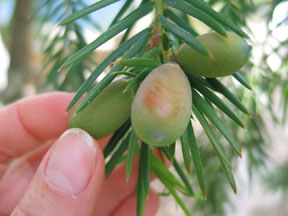 7
7 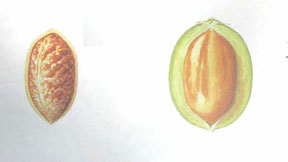 8
8
7 and 8: Seeds of California Torreya, with fleshy sarcotesta — originally to entice tortoise dispersers(?) and now stripped by squirrels before the seed is buried or eaten. Photo 20 May 2005 Yosemite.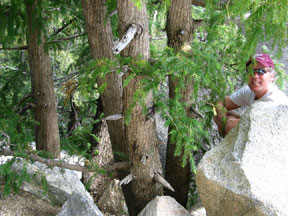 9
9 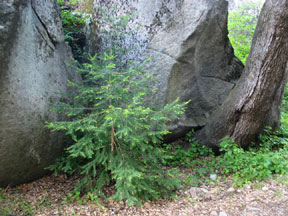 10
10
9: Four stems of female Torreya (possibly all same genotype).
10: Torreya sapling by boulder, poison oak right ground. (Both photos in Yosemite). 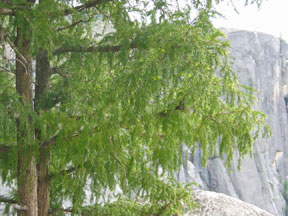 11
11 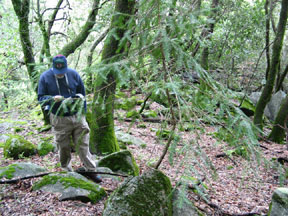 12
12
11: Unusually full and brushy foliage of Torreya in full sun, Yosemite roadside.
12: More typical, spindly form with planar flat foliage, growing in shade, Sequoia Park.
 13
13  14
14
13: Several stump sprouts, with decomposing bigger stem still standing to right.
14: Two generations of sprouts (injured by animals) growing along a still healthy big stem. This was the only instance of animal damage I noticed in all three sites, and I witnessed no evidence of disease on bark or foliage.
(Both photos Sequoia National Park.) 15
15  16
16
15: Connie not quite able to clasp hands around 51 inch circumference. The companion stem (which her walking stick leans against) is 60 inch circumference. It is difficult to see the cliff-edge in this photo, but the 60-incher leaned out so far that it was scary to measure.
16: A triplet: Middle stem is 63 inches, right is 52; both combined at breast height is 96. Oak is to the right. Both photos looking downward toward cliff-edge at Sequoia National Park. 17
17  18
18
17: Horizontally leaning Torreya in Yosemite dry site.
18: View of a forest opening from the same Torreya-rich slope.
 19
19  20
20
19: Brushy full-sun clump of 4 female Torreya stems (same as photo 9), next to white van.
20: Small brushy Torreya (center bottom of photo) where vegetation begins at top of road cut; blueish manzanita foliage to its immediate right).  21
21  22
22
21: View down from the Yosemite Site A pullout pictured in photos 19 and 20. You can also see Site B in this photo, which begins just beyond (downstream) of the leftward curve in the Merced River, and continues to the Park entrance booth just beyond what is visible here. Basically, you have to drive past where Doug Firs and Ponderosa Pines line the road and get to the drier, steeper sites at road edge, including some excellent rockslides.
22: At Site B, a small brushy Torreya immediately behind boulder), with California Bay Laurel to left and a lone, tall Ponderosa Pine behind. (Ponderosa Pines were very rare on this south-facing, roadside slope.)

23. Foliage is variable. Upper left is Douglas-Fir-like bushiness of the full-sun female Torreya pictured in photos #11 and #19. Upper right is a full-sun male at the same location in Yosemite National Park (elevation 5000 feet). Lower foliage was collected, fallen, at the base of the giant trio in Sequoia National Park, pictured in photo #16. Notice how much flatter is the branchlet, in addition to large size.